Introduction
Cybersecurity faces escalating threats—from sophisticated ransomware attacks to phishing schemes and zero-day exploits. Traditional security tools often struggle to keep pace with evolving tactics and the sheer volume of attacks.
That’s where AI steps in as a game-changer. Offering automation, predictive insights, and rapid threat detection, AI empowers you to safeguard your organization proactively. This guide explores how AI-driven solutions are reshaping cybersecurity into a dynamic, intelligent defense system that works for you.
What is AI and Why Does It Matter in Cybersecurity?
Cyber threats are evolving faster than ever, and traditional defenses struggle to keep up. AI empowers your security team to detect, predict, and respond to attacks with speed and accuracy that manual processes simply can’t match.
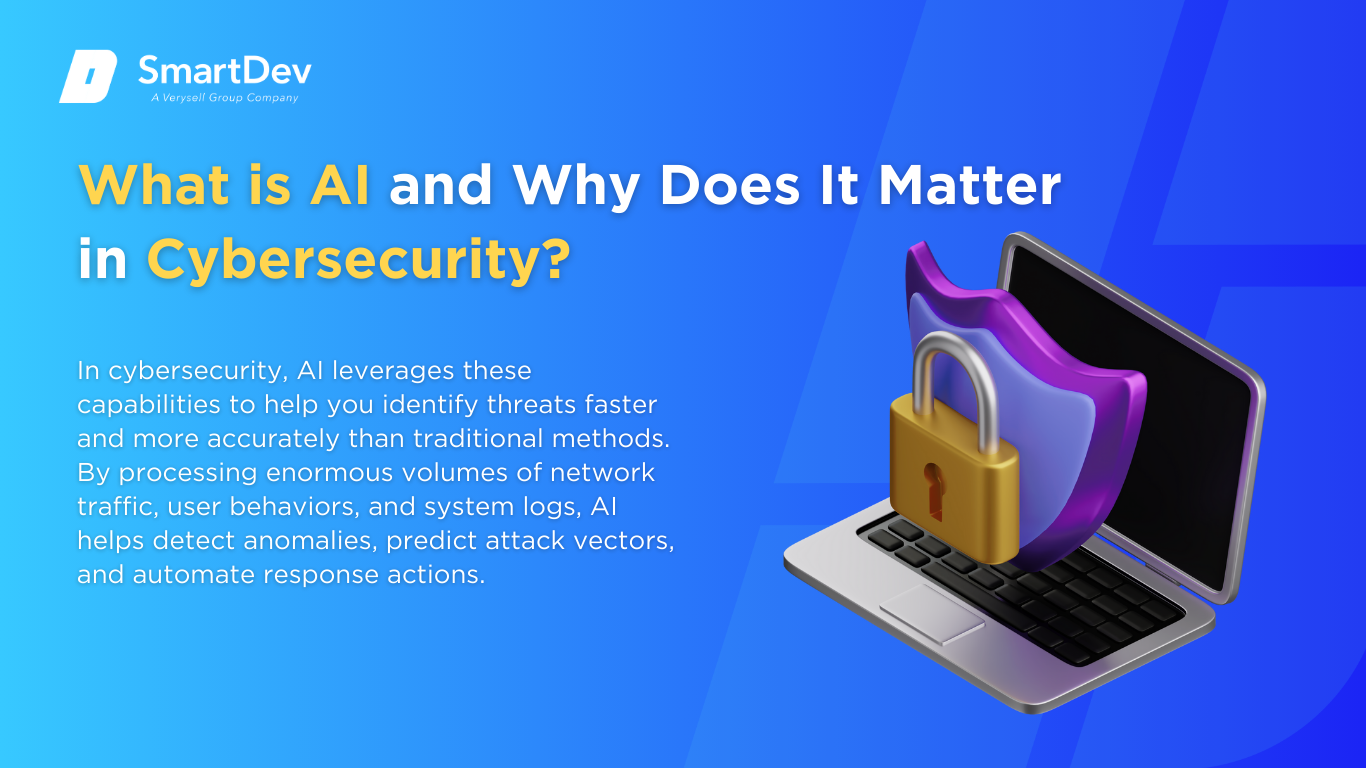
Definition of AI and Its Core Technologies
IBM defines AI as a technology that can sense, comprehend, act and learn – mimicking human cognitive functions. Core AI technologies like machine learning, natural language processing (NLP), and computer vision enable machines to analyze vast data sets, recognize patterns, and make autonomous decisions with minimal human input.
In cybersecurity, AI leverages these capabilities to help you identify threats faster and more accurately than traditional methods. By processing enormous volumes of network traffic, user behaviors, and system logs, AI helps detect anomalies, predict attack vectors, and automate response actions. This shift from reactive to proactive defense is crucial in an industry where milliseconds can mean the difference between a breach and a blockade.
The Growing Role of AI in Transforming Cybersecurity
AI-driven cybersecurity tools have become indispensable for organizations facing increasing attack sophistication and volume. Machine learning models analyze patterns across millions of data points to detect subtle signs of intrusion that humans might miss. For example, anomaly detection algorithms identify deviations in user behavior indicating insider threats or compromised accounts.
Automation powered by AI reduces your response times significantly. Instead of relying on manual triage of alerts, AI systems can instantly quarantine suspicious files or isolate infected endpoints, containing threats before they spread. This capability is critical given the shortage of skilled cybersecurity professionals worldwide.
Beyond detection and response, AI enhances threat hunting by correlating data from multiple sources – threat feeds, logs, and external intelligence – to uncover emerging attack campaigns. This holistic view enables organizations to anticipate adversary moves and strengthen your security posture proactively.
Key Statistics and Trends Highlighting AI Adoption in Cybersecurity
AI adoption in cybersecurity is accelerating as threats become more complex. According to a 2024 report by MarketsandMarkets, the global AI in cybersecurity market was valued at USD 22.4 billion in 2023 and is expected to grow at a CAGR of 21.9% from 2023 to 2028. The revenue forecast for 2028 is projected to reach $60.6 billion. This surge is driven by demand for faster threat detection and automated incident response.
Research from Gartner reveals that by 2025, 75% of security operations centers (SOCs) will utilize AI and machine learning tools to augment human analysts, up from just 40% in 2022. Early adopters report up to 50% reduction in incident response times, highlighting AI’s operational impact on your security team.
Furthermore, the 2023 IBM Cost of a Data Breach Report found organizations deploying AI-based security measures reduced breach costs by an average of $3.58 million, underscoring the financial value of investing in AI for your cybersecurity defense.
Business Benefits of AI in Cybersecurity
AI delivers measurable value by addressing critical cybersecurity challenges such as alert overload, complex threat landscapes, and limited human resources. By integrating AI into your security operations, you can boost efficiency and transform your defense posture to be more proactive and adaptive against evolving cyber threats.
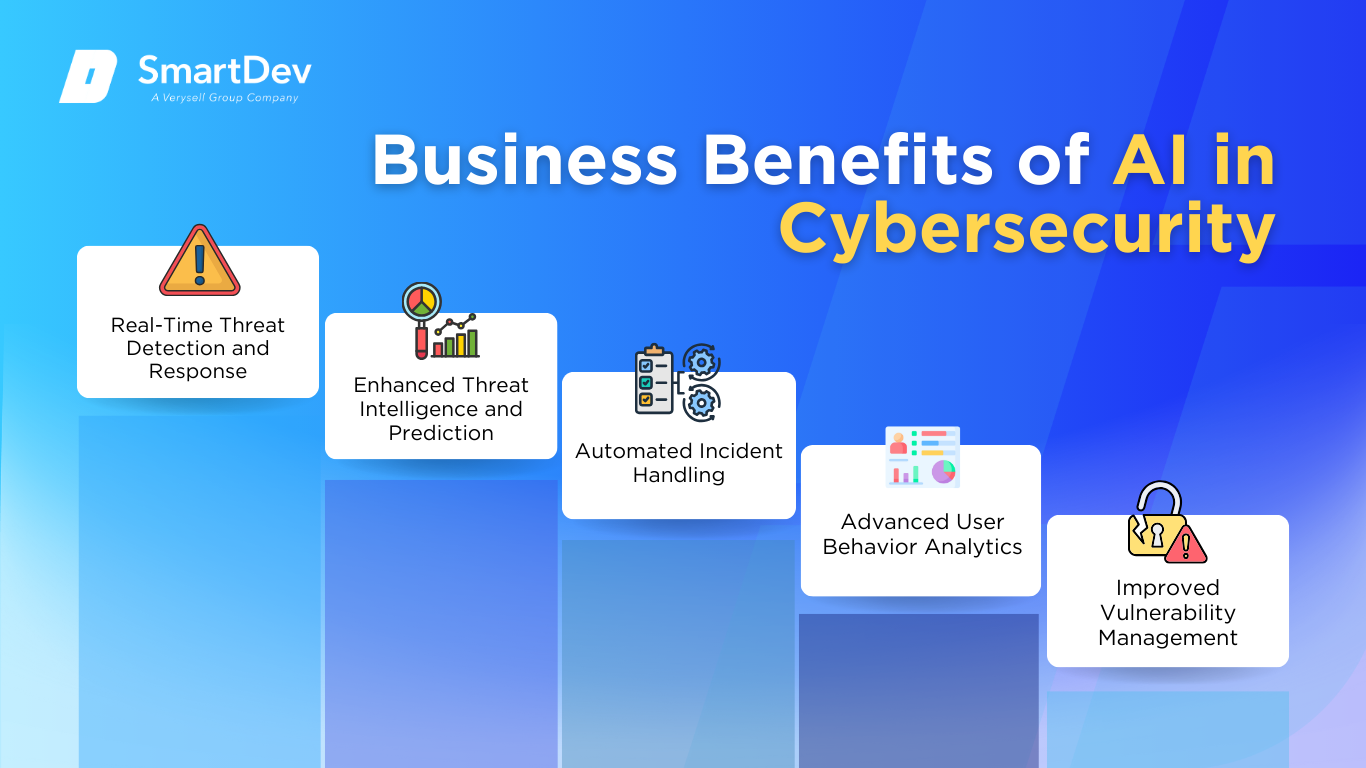
1. Real-Time Threat Detection and Response
AI technologies continuously analyze vast amounts of your network data and user activities to detect anomalies and threats as they happen. This real-time processing drastically reduces the time from breach to detection, which is critical for preventing extensive damage. While traditional tools may lag, AI’s ability to learn and adapt enables your team to contain attacks faster.
According to IBM’s 2024 Cost of a Data Breach Report, organizations extensively deploying security AI and automation detected and contained incidents an average of 106 days faster than those without such technologies. This acceleration significantly eases breach impact and lessens the strain on your resources.
2. Enhanced Threat Intelligence and Prediction
AI aggregates threat data from diverse sources such as global attack databases, dark web monitoring, and malware repositories, enabling you to anticipate attack patterns and emerging vulnerabilities. This predictive intelligence helps you prioritize defenses and patch critical gaps before attackers exploit them.
By proactively adjusting your security controls based on AI-driven forecasts, you reduce the window of exposure to zero-day attacks and other sophisticated threats. This shift from reactive to predictive security builds resilience and gives you a strategic edge against fast-moving adversaries.
3. Automated Incident Handling
Manual incident management is time-consuming and often overwhelmed by the sheer volume of alerts. AI automates response workflows by executing predefined actions like quarantining infected endpoints or blocking malicious IP addresses immediately upon detecting suspicious activity. This automation speeds containment and reduces the risk of human error.
By relieving analysts from routine tasks, AI enables security personnel to concentrate on investigating complex threats and refining defensive strategies. The resulting efficiency gains can lead to improved threat mitigation without expanding the team size.
4. Advanced User Behavior Analytics (UBA)
AI-powered UBA models learn typical user behavior patterns and detect subtle deviations that may signal insider threats or compromised credentials. These insights are crucial since insider attacks are difficult to spot with signature-based tools but can cause significant damage if undetected. Early identification of suspicious activities helps organizations intervene before sensitive data is exposed or systems are breached.
Moreover, AI continuously refines these behavioral models to adapt to changing work habits and evolving threat techniques. This dynamic learning makes UBA a powerful tool in maintaining robust internal security controls.
5. Improved Vulnerability Management
AI accelerates vulnerability discovery and risk prioritization by scanning networks, applications, and code with greater speed and accuracy than traditional scanners. Using natural language processing, AI also analyzes threat advisories and exploit databases to assess which vulnerabilities pose the greatest real-world risks. This focused insight helps organizations patch critical weaknesses faster and more efficiently.
The 2023 IBM Cost of a Data Breach Report highlights that companies using AI-driven vulnerability management reduce breach-related costs by an average of $3.58 million. This significant cost saving demonstrates how AI not only strengthens security but also provides tangible financial benefits.
Challenges Facing AI Adoption in Cybersecurity
Despite AI’s promise, organizations face several barriers to full adoption and effective use in cybersecurity.
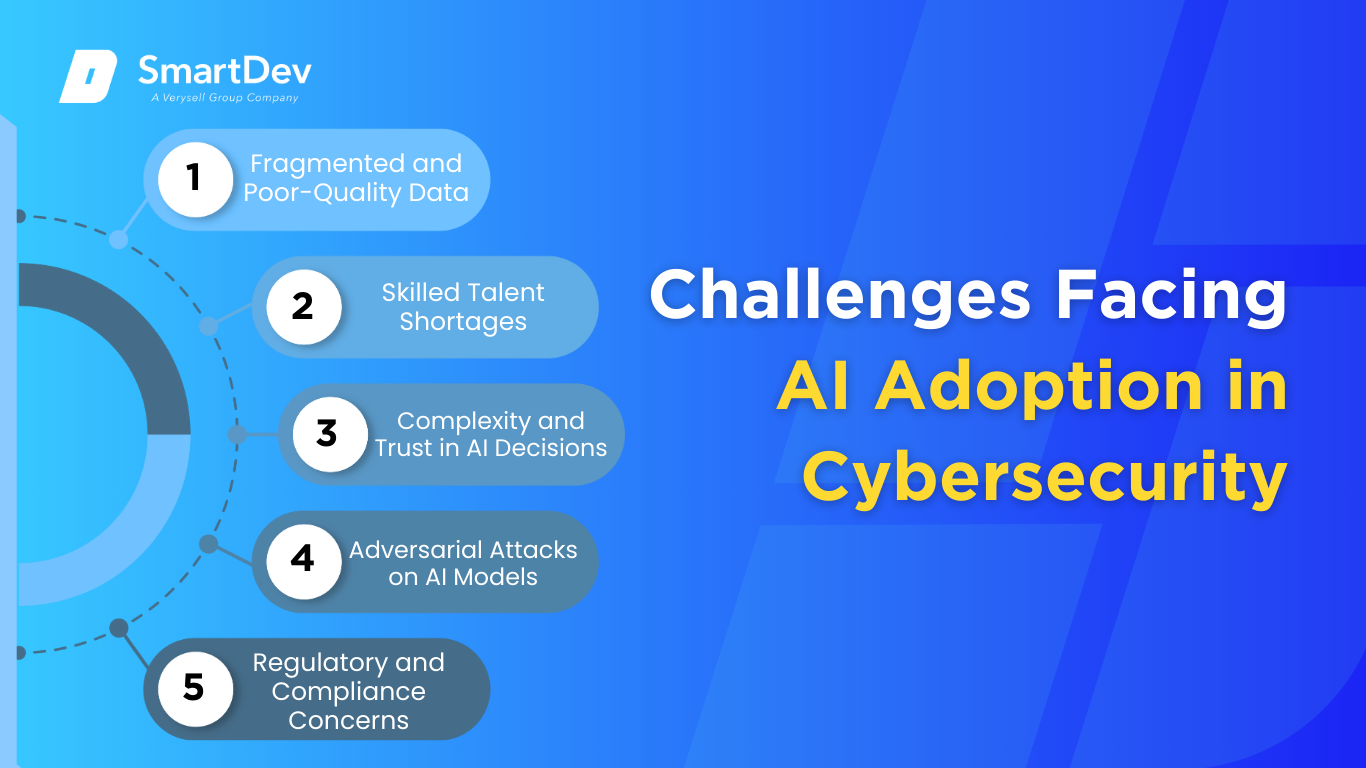
1. Fragmented and Poor-Quality Data
One of the biggest hurdles you may face when implementing AI in cybersecurity is managing fragmented and inconsistent data. Cybersecurity data is often scattered across various tools, formats, and environments – logs, alerts, network traffic, and threat feeds – making it difficult for AI systems to generate accurate insights. Without a unified and clean data foundation, AI’s predictive capabilities and threat detection accuracy can suffer significantly.
Moreover, maintaining high data quality is not just a technical issue but also an organizational challenge. It requires ongoing coordination between your security, IT, and operations teams to ensure data is continuously cleansed, normalized, and properly labeled. Without this, AI may produce false positives or miss subtle threats, undermining your confidence in the technology.
2. Skilled Talent Shortages
While AI can automate many cybersecurity tasks, you still need skilled professionals to develop, manage, and interpret these complex AI systems effectively. The cybersecurity industry is already experiencing a significant talent shortage and finding experts who also understand AI and machine learning is even harder. This talent gap can slow down your AI adoption and limit the full potential of your security investments.
The 2023 ISC2 Cybersecurity Workforce Study reveals the workforce gap has reached a record high, with 4 million professionals still needed to adequately safeguard digital assets worldwide. This means your security team might be stretched thin, juggling AI system management alongside other critical duties. As a result, AI tools may be underutilized or misconfigured, limiting their effectiveness in protecting your organization.
3. Complexity and Trust in AI Decisions
AI’s decision-making process is often seen as a “black box,” making it hard for your security analysts to understand why a particular alert or action was triggered. This lack of transparency can create trust issues, causing hesitation to fully rely on AI-driven automation for critical security responses. Without clear explanations, your team might second-guess AI findings or hesitate to act quickly, reducing the technology’s effectiveness.
Building trust requires not only better explainability but also integrating AI with your existing workflows in a way that augments human decision-making rather than replaces it. When you empower your analysts with interpretable AI insights, they are more likely to adopt and optimize AI tools, ultimately strengthening your cybersecurity defenses.
4. Adversarial Attacks on AI Models
Cyber adversaries are not just targeting your systems – they are increasingly targeting the AI models themselves. By feeding manipulated or malicious data into AI systems, attackers aim to confuse or evade detection, a tactic known as adversarial attacks. This evolving threat vector puts your AI defenses at risk, requiring continuous validation and hardening of models.
Maintaining AI robustness demands ongoing vigilance and investment. You need to monitor your AI’s performance closely, retrain models with fresh data, and implement safeguards to detect when AI outputs may be compromised. Ignoring this can leave your security exposed to sophisticated attackers exploiting your most advanced defenses.
5. Regulatory and Compliance Concerns
Deploying AI in cybersecurity also brings challenges related to regulatory compliance and data privacy. You must ensure that your AI systems handle sensitive data in accordance with laws such as GDPR, CCPA, or sector-specific regulations. Failing to do so can result in legal penalties and damage to your organization’s reputation.
In addition, maintaining audit trails for AI-driven decisions is critical for compliance and incident investigations. You need transparency not only in how AI makes decisions but also in how data flows through your AI processes. Balancing innovation with compliance requires clear policies and collaboration across your legal, security, and IT teams to avoid costly missteps.
Specific Applications of AI in Cybersecurity
AI is revolutionizing how organizations defend themselves against cyber threats by enabling smarter, faster, and more precise security measures. Let’s explore some key AI-powered applications that are transforming cybersecurity from reactive defense to proactive protection.
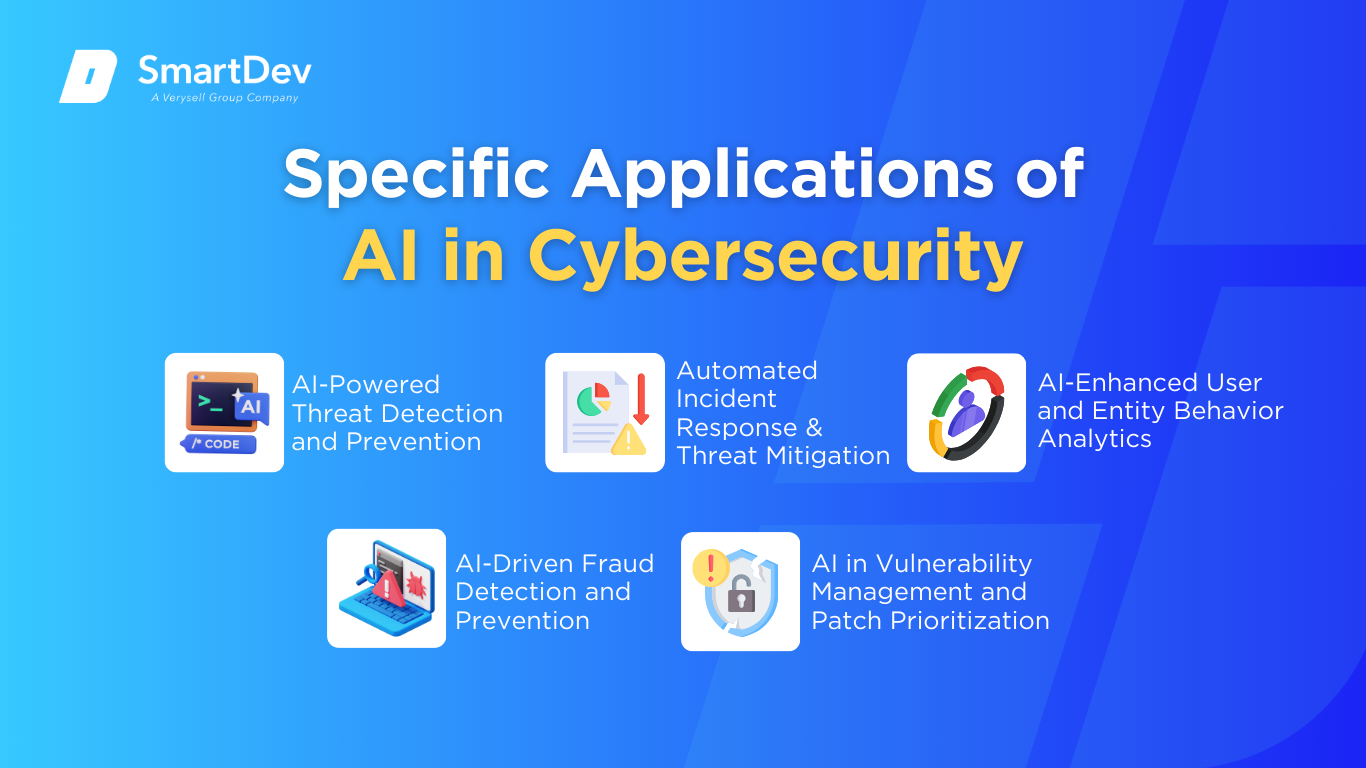
1. AI-Powered Threat Detection and Prevention
AI-powered threat detection enables organizations to identify cyber threats quickly and accurately by analyzing vast amounts of network and endpoint data. This application solves the problem of detecting increasingly sophisticated attacks that traditional signature-based systems often miss. AI models learn from historic attack patterns and continuously update to recognize novel threats, making detection more adaptive and timely.
Technically, this involves supervised and unsupervised machine learning, anomaly detection, and pattern recognition. AI ingests data such as network flows, system logs, and user activity, and integrates with SIEM and EDR platforms. This results in prioritized alerts with reduced false positives, helping security teams focus on real threats without overwhelming them.
Cylance, acquired by BlackBerry, uses AI to predict malware behavior before execution, preventing infections at the endpoint. Their AI models were trained on millions of malware and benign samples, enabling identification of threats even with no prior signature. In a healthcare client deployment, Cylance prevented 99.7% of malware attacks, reducing security incidents drastically. The AI-driven approach also decreased system resource usage compared to traditional antivirus, enabling smoother operations.
2. Automated Incident Response and Threat Mitigation
Automated incident response uses AI to accelerate containment and remediation of cyber threats, addressing the critical delay in human response during fast-moving attacks. By automating routine response actions – such as isolating endpoints or blocking IP addresses – AI reduces damage and operational disruption.
This application employs rule-based logic combined with reinforcement learning to select optimal mitigation strategies based on attack context. Integrated with SOAR platforms, it orchestrates automated workflows across multiple security tools, ensuring consistent and rapid action.
IBM’s QRadar Advisor with Watson integrates AI-powered threat intelligence with automated playbooks. Watson’s natural language processing analyzes vast threat data, assisting analysts in understanding attack context and recommending response steps. One enterprise client reduced their mean time to detect by 30% and mean time to respond by 25%, leading to fewer data breaches and faster recovery. This allowed their SOC team to handle more incidents without expanding headcount.
3. AI-Enhanced User and Entity Behavior Analytics (UEBA)
UEBA uses AI to create behavioral profiles of users and devices, detecting insider threats and account compromises that traditional perimeter defenses miss. By analyzing login times, resource access, and data transfer patterns, AI spots unusual behavior signaling fraud or sabotage. This granular monitoring is critical in industries where insider risk is high.
Machine learning models process diverse logs from identity management systems, endpoint sensors, and network traffic. They continuously update behavioral baselines, flagging deviations for investigation. UEBA’s integration with SIEMs enriches alerts with contextual insights, helping prioritize high-risk events.
Splunk’s UEBA platform significantly enhances insider threat detection. In a financial institution, the solution identified a compromised employee account accessing sensitive data outside business hours. Splunk’s AI reduced false positive rates by 40%, which helped focus analyst attention on genuine threats. Post-deployment, the client improved breach detection speed by 35%, preventing data exfiltration incidents.
4. AI-Driven Fraud Detection and Prevention
Fraud detection in cybersecurity demands rapid, accurate analysis of complex transactions to prevent losses. AI’s ability to learn evolving fraud patterns and detect subtle anomalies outperforms static rule-based systems. Real-time scoring of transactions allows instant blocking or flagging.
Supervised learning models trained on historic fraud data analyze transaction metadata, user device info, and geolocation. This multilayered analysis improves detection rates while reducing false positives, maintaining user convenience.
PayPal’s AI fraud prevention system analyzes billions of transactions daily using deep learning and graph analytics. Their AI identifies subtle behavioral anomalies indicative of fraud, preventing millions of dollars in losses yearly. In a recent update, PayPal’s AI reduced false declines by 25%, improving customer satisfaction and retention.
5. AI in Vulnerability Management and Patch Prioritization
With thousands of vulnerabilities disclosed yearly, prioritizing fixes is essential to effective cybersecurity. AI models assess real-world exploitability and threat intelligence to rank vulnerabilities by actual risk, rather than static severity scores. This helps organizations allocate limited resources efficiently.
Machine learning integrates data from vulnerability scanners, exploit databases, threat feeds, and asset inventories to produce dynamic risk scores. This contextual approach guides security teams in patching the most critical issues first, reducing exposure and compliance gaps.
Tenable’s Risk-Based Vulnerability Management (RBVM) platform applies AI to correlate threat intelligence with asset importance. One large enterprise reduced their patch backlog by 60%, focusing on vulnerabilities likely to be exploited in their environment. This led to a measurable decrease in security incidents and improved audit readiness.
Examples of AI in Cybersecurity
Real-World Case Studies
Building on the specific applications discussed, this section highlights real-world case studies showcasing how AI delivers measurable value in cybersecurity. These examples demonstrate practical success in threat detection, incident response, and behavior analytics, reinforcing the strategic importance of AI adoption.
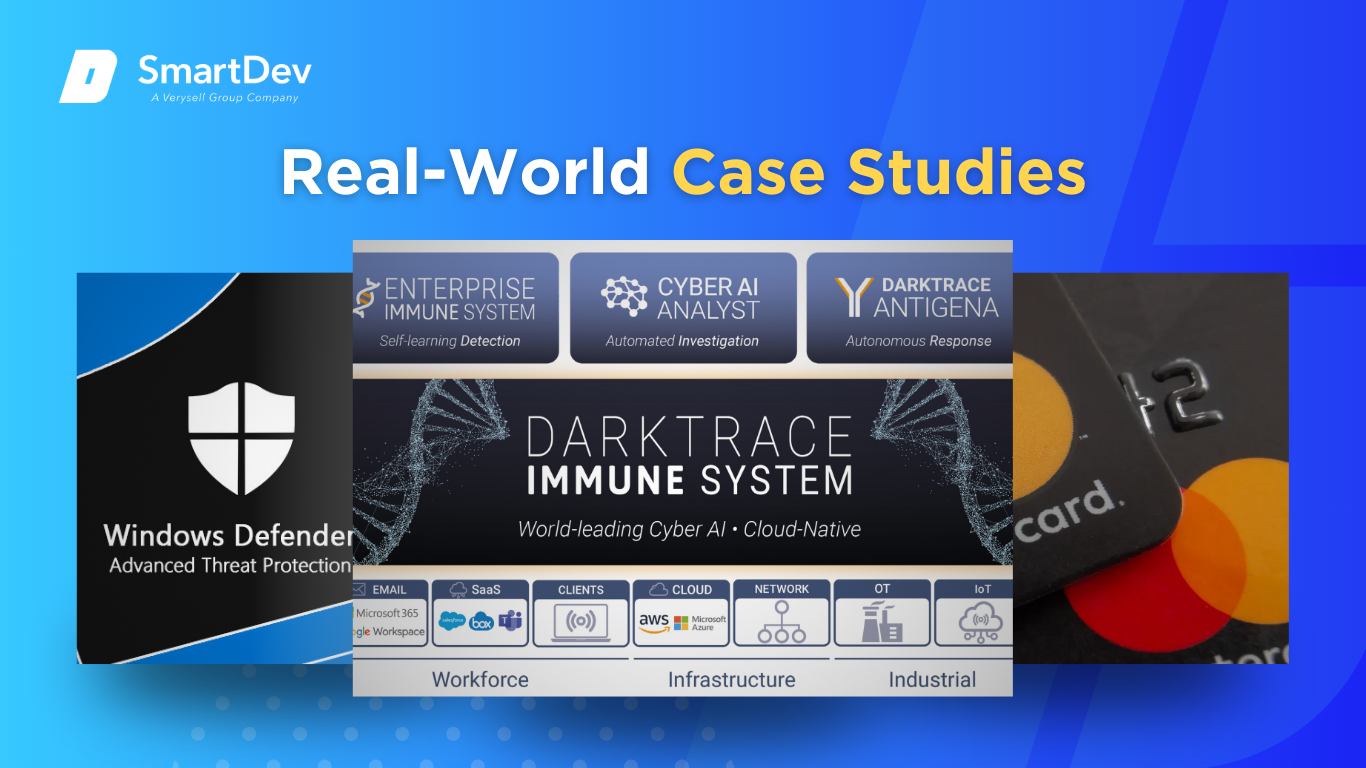
Darktrace: Enterprise Immune System
Darktrace uses unsupervised machine learning to build a ‘digital immune system’ that learns what normal behavior looks like across a network. This allows it to detect subtle anomalies caused by zero-day exploits or insider threats without relying on known signatures. The AI adapts continuously, reducing false positives and improving detection accuracy.
One major financial services client saw a 90% reduction in threat detection time, identifying risks within minutes instead of hours or days. Darktrace’s AI also prevented a ransomware attack by spotting unusual internal file encryption early, stopping damage to critical assets. This quick detection helped avoid costly downtime and data loss.
Microsoft Defender ATP: Automated Threat Detection and Response
Microsoft Defender Advanced Threat Protection (ATP) combines AI-driven behavioral analytics with automated response capabilities to protect enterprise networks. Leveraging vast telemetry data from global devices, AI models detect anomalies indicative of advanced persistent threats, phishing attempts, and malware infections. Its integration with Microsoft’s cloud ecosystem enhances threat intelligence sharing and coordinated defense.
Organizations using Defender ATP have realized up to a 50% reduction in detection times and a corresponding decline in malware infections. For instance, a multinational technology firm reported significant improvements in incident containment, reducing the mean time to respond (MTTR) by nearly one-third. The solution’s automation capabilities also alleviate analyst workloads, improving SOC productivity.
Mastercard: Decision Intelligence Platform
Mastercard’s Decision Intelligence platform applies AI to analyze billions of transactions worldwide, identifying emerging fraud patterns in real time. Its machine learning models dynamically adjust fraud detection rules, enabling the system to adapt to new threats quickly. This approach reduces manual intervention and improves fraud prevention effectiveness.
As a result, Mastercard has cut false declines by up to 50%, improving the customer experience while maintaining security. The platform balances convenience with protection, safeguarding millions of users and preserving trust. Its insights also help risk teams anticipate and prepare for future fraud trends.
Vectra AI: Network Traffic Analysis and Threat Hunting
Vectra AI specializes in AI-powered network threat detection, focusing on real-time analysis of network metadata to identify hidden attacker behaviors. Its Cognito platform employs deep learning to detect lateral movement, command-and-control traffic, and data exfiltration attempts without decrypting network packets, thus preserving privacy while enhancing security.
Clients deploying Vectra have experienced a 70% reduction in threat dwell time—the period attackers remain undetected in networks. For example, a financial services company using Cognito reported faster prioritization of critical incidents and an improved ability to respond proactively to advanced persistent threats. This comprehensive network visibility has been instrumental in minimizing business disruptions and potential losses.
Innovative AI Solutions
Emerging AI technologies continue to push the boundaries of cybersecurity innovation, introducing new methods to anticipate and neutralize threats. Explainable AI (XAI) is gaining momentum, helping security professionals understand how AI models reach their decisions. By increasing transparency, XAI builds analyst trust and facilitates regulatory compliance.
Another innovative approach is AI-powered deception technology, which uses dynamic decoys and traps to lure attackers and study their behavior in controlled environments. This proactive defense not only detects intrusions early but also generates valuable intelligence for future threat mitigation. Such techniques transform cybersecurity from a reactive to a proactive discipline.
Additionally, federated learning and privacy-preserving AI enable organizations to collaboratively improve threat detection models without sharing sensitive data. This distributed AI training accelerates collective defense against cyber threats while maintaining data privacy, heralding a new era of secure, cooperative cybersecurity.
AI-Driven Innovations Transforming Cybersecurity
Emerging Technologies in AI for Cybersecurity
Emerging AI technologies continue to push the boundaries of cybersecurity innovation, introducing new methods to anticipate and neutralize threats. Explainable AI (XAI) is gaining momentum, helping security professionals understand how AI models reach their decisions. By increasing transparency, XAI builds analyst trust and facilitates regulatory compliance.
Another innovative approach is AI-powered deception technology, which uses dynamic decoys and traps to lure attackers and study their behavior in controlled environments. This proactive defense not only detects intrusions early but also generates valuable intelligence for future threat mitigation. Such techniques transform cybersecurity from a reactive to a proactive discipline.
Additionally, federated learning and privacy-preserving AI enable organizations to collaboratively improve threat detection models without sharing sensitive data. This distributed AI training accelerates collective defense against cyber threats while maintaining data privacy, heralding a new era of secure, cooperative cybersecurity.
AI’s Role in Sustainability Efforts
Beyond threat detection, AI is also driving sustainability in cybersecurity operation – an often-overlooked but increasingly crucial benefit. Traditional cybersecurity tools, especially those reliant on constant manual intervention, consume substantial computing power and human resources. AI helps streamline these operations by automating tasks and reducing redundancy, which not only improves efficiency but cuts down energy consumption across digital infrastructure.
AI also enables smarter resource allocation through predictive analytics. By forecasting where threats are most likely to occur, organizations can deploy their resources more strategically – avoiding unnecessary system scans, limiting over-provisioned infrastructure, and minimizing operational waste. This predictive efficiency reduces carbon footprints and aligns cybersecurity with broader ESG (Environmental, Social, Governance) goals.
In the age of green IT and corporate responsibility, integrating AI into cybersecurity isn’t just about defense – it’s about smarter, cleaner, and more conscious technology management. Businesses that invest in AI not only enhance protection but contribute to a more sustainable digital ecosystem.
How to Implement AI in Cybersecurity

Step 1: Assessing Readiness for AI Adoption
Start by identifying which cybersecurity areas – like threat detection or incident response – would benefit most from AI. Also, evaluate whether your existing data is sufficient and reliable for AI analysis. It’s equally important to prepare your teams and organizational culture to embrace AI, fostering collaboration between security experts and data scientists.
Step 2: Building a Strong Data Foundation
Collecting and cleaning security data is essential for AI to accurately detect threats. Ensure your data management also complies with privacy and security regulations. Set up scalable infrastructure that supports real-time data processing so AI models can continuously learn and adapt to new threats.
Step 3: Choosing the Right Tools and Vendors
Choose AI solutions designed specifically for cybersecurity that integrate smoothly with your existing tools like SIEM and endpoint protection. Transparency in AI decision-making helps build trust among security teams. Look for vendors who offer strong support and scalable platforms that grow with your security needs.
Step 4: Pilot Testing and Scaling Up
Begin with small pilot projects targeting specific security challenges to test AI effectiveness and gather feedback. This approach reduces risks and improves outcomes. Once successful, expand AI deployment across security workflows, ensuring continuous model updates to keep pace with evolving threats.
Step 5: Training Teams for Successful Implementation
Invest in upskilling your security teams to interpret AI insights and manage AI-driven tools effectively. This helps create a partnership between human expertise and AI capabilities. Encourage ongoing collaboration between cybersecurity and AI specialists to maximize AI’s impact on your security posture.
Measuring the ROI of AI in Cybersecurity
Key Metrics to Track Success
Measuring the return on investment (ROI) of AI in cybersecurity involves analyzing both tangible and intangible benefits. Productivity improvements are often seen as the most immediate gain, with AI automating routine tasks like log analysis, threat hunting, and alert triaging. This frees cybersecurity professionals to focus on higher-value activities, boosting overall team efficiency and reducing burnout.
Cost savings are another critical metric. By preventing breaches, AI helps avoid the hefty financial fallout from data loss, regulatory fines, and reputational damage. Automated threat detection and response also reduce the need for extensive manual investigation and long incident resolution times, cutting operational costs. Organizations should track incident frequency, mean time to detect (MTTD), and mean time to respond (MTTR) to quantify these benefits accurately.
Case Studies Demonstrating ROI
Consider the example of a global financial services firm that integrated AI-driven threat detection into its cybersecurity framework. Within six months, the company reported a 40% reduction in false positives, significantly decreasing the time analysts spent on unnecessary alerts. This improvement allowed the team to focus on genuine threats, reducing MTTD by 30%. Financially, the firm estimated savings of $3 million annually by avoiding potential breaches and optimizing manpower.
Another compelling case comes from a healthcare provider using AI for predictive analytics to monitor network vulnerabilities. The system proactively flagged risky behaviors and emerging threats, leading to a 25% drop in security incidents over one year. By automating compliance reporting and audit preparations, the provider saved over 1,200 hours of manual work, translating into $500,000 in operational savings.
These real-world examples highlight how AI doesn’t just enhance security – it delivers measurable value that directly impacts the bottom line.
Common Pitfalls and How to Avoid Them
Despite AI’s promise, many organizations stumble during adoption due to unrealistic expectations or inadequate preparation. One common pitfall is overreliance on AI without human oversight. AI tools can produce false positives or miss novel attack vectors if not regularly tuned and monitored by experts.
Another challenge is insufficient data quality. Poor or fragmented data leads to inaccurate AI predictions, undermining trust in the system. To avoid these issues, establish clear governance policies and maintain ongoing collaboration between AI engineers and cybersecurity analysts. Investing in continuous training and iterative refinement ensures AI solutions remain effective and aligned with evolving threats.
Future Trends of AI in Cybersecurity

Predictions for the Next Decade
Looking ahead, AI’s role in cybersecurity will become even more sophisticated and integrated. We expect the rise of autonomous security operations centers (SOCs) powered by AI, where machines independently detect, investigate, and respond to threats with minimal human intervention. Advances in natural language processing (NLP) will enable AI to understand and analyze threat intelligence feeds, security reports, and hacker forums in real time, enhancing proactive defense strategies.
Moreover, AI-driven cyber deception technologies – like honeypots and decoy systems – will evolve to mislead attackers more effectively, buying time for response teams. The integration of AI with blockchain could also bolster identity management and data integrity, closing critical gaps in supply chain security.
How Businesses Can Stay Ahead of the Curve
To stay competitive, businesses must embrace AI not as a standalone tool but as part of a holistic cybersecurity strategy. This involves fostering a culture of continuous learning, investing in research partnerships, and staying informed about emerging AI capabilities and cyber threats.
Collaborating with AI vendors and cybersecurity experts will help organizations tailor solutions that fit their unique risk profiles. Proactively revisiting security policies, compliance standards, and data governance ensures AI implementations remain ethical, secure, and effective. Ultimately, adaptability and strategic foresight will determine who thrives in the AI-powered cybersecurity future.
Conclusion
Key Takeaways
AI is transforming cybersecurity by enhancing threat detection, automating response, and enabling predictive defense. Emerging technologies like generative AI and computer vision add new layers of protection, while AI-driven sustainability efforts optimize resource use. Successful AI adoption requires readiness assessment, strong data foundations, careful tool selection, pilot testing, and ongoing team training.
Measuring ROI through productivity gains and cost savings is vital, with case studies underscoring AI’s financial and operational impact. Awareness of common pitfalls helps ensure smooth implementation. Looking forward, autonomous SOCs, AI-powered deception, and advanced analytics will shape cybersecurity’s next frontier.
Moving Forward: A Path to Progress
If you’re ready to elevate your cybersecurity posture, now is the time to explore AI-driven solutions. Start by evaluating your organization’s unique challenges and data readiness. Partner with trusted AI vendors like SmartDev and pilot innovative tools to unlock actionable insights. Invest in your team’s skills and foster a culture where human expertise and AI work hand-in-hand.
By embracing AI thoughtfully and strategically, your business can not only defend against today’s threats but also future-proof its security for the decade ahead. Don’t wait for the next breach – take the proactive step towards AI-enhanced cybersecurity today. Contact SmartDev to get started on your AI cybersecurity journey now!
—
References:
- Artificial Intelligence (AI) in Cyber Security Market | MarketsandMarkets
- Predict 2025: There Will Never Be an Autonomous SOC | Gartner
- Cost of a Data Breach Report | IBM
- ISC2 Reveals Workforce Growth But Record-Breaking Gap of 4 Million Cybersecurity Professionals | ISC2
- Predictive AI for Cybersecurity | Blackberry
- IBM Security QRadar Advisor with Watson | IBM Media Center
- Enterprise Immune System | CyberAIWorks
- Mastercard Launches Gen AI Tool to Better Protect Consumers | FinTech Magazine







